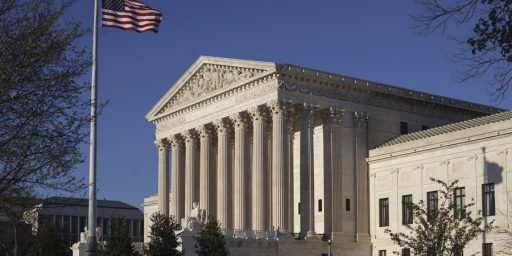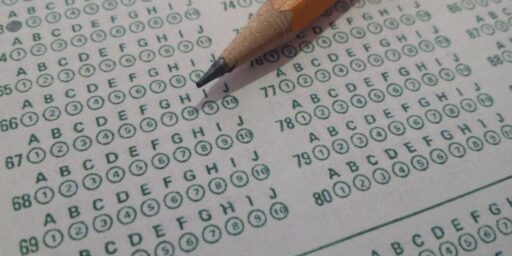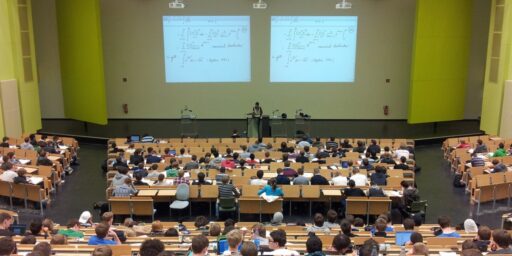Affirmative Action for Rich, White Kids?
Peter Schmidt, deputy editor of The Chronicle of Higher Education and author of Color and Money: How Rich White Kids Are Winning the War Over College Affirmative Action, argues in a recent Boston Globe op-ed that more whites than minorities who don’t make the grade are admitted to elite schools.
Researchers with access to closely guarded college admissions data have found that, on the whole, about 15 percent of freshmen enrolled at America’s highly selective colleges are white teens who failed to meet their institutions’ minimum admissions standards.
Five years ago, two researchers working for the Educational Testing Service, Anthony Carnevale and Stephen Rose, took the academic profiles of students admitted into 146 colleges in the top two tiers of Barron’s college guide and matched them up against the institutions’ advertised requirements in terms of high school grade point average, SAT or ACT scores, letters of recommendation, and records of involvement in extracurricular activities. White students who failed to make the grade on all counts were nearly twice as prevalent on such campuses as black and Hispanic students who received an admissions break based on their ethnicity or race.
Who are these mediocre white students getting into institutions such as Harvard, Wellesley, Notre Dame, Duke, and the University of Virginia? A sizable number are recruited athletes who, research has shown, will perform worse on average than other students with similar academic profiles, mainly as a result of the demands their coaches will place on them.
A larger share, however, are students who gained admission through their ties to people the institution wanted to keep happy, with alumni, donors, faculty members, administrators, and politicians topping the list.
Applicants who stood no chance of gaining admission without connections are only the most blatant beneficiaries of such admissions preferences. Except perhaps at the very summit of the applicant pile – that lofty place occupied by young people too brilliant for anyone in their right mind to turn down – colleges routinely favor those who have connections over those who don’t. While some applicants gain admission by legitimately beating out their peers, many others get into exclusive colleges the same way people get into trendy night clubs, by knowing the management or flashing cash at the person manning the velvet rope.
Of course, the numbers are a little skewed for the sake of being provocative. By definition, minority set-asides apply to a relatively small number of people. If the “numerical target” (remember, quotas were ruled unconstitutional thirty years ago) is 12 percent and 7 percent are found using the normal process, the delta necessary to make up by putting one’s thumb on the scale is just 5 percent. Conversely, the vast majority of wealthy alumni from these institutions — or just people wealthy enough to make it worth Harvard’s while — are going to be white. It’s also true that racial discrimination is specifically prohibited by the 14th Amendment and a whole host of legislation whereas giving special privileges to the rich and famous is as American as apple pie.
Still, one would think skewing the admissions process to give the benefit of the doubt to those from less privileged backgrounds (as Justice Thomas put it last night, those “running the race uphill”) would be more desirable than rewarding those who have every advantage life has to offer. (Race and ethnicity are poor proxies for “underprivileged” and even “diverse,” but that’s at least the theory behind affirmative action.) Yet there’s little discussion of the phenomenon, let alone the animus reserved for race-based preferences.
The interesting side issue Schmidt touches upon — rather amusing in that, defying stereotype, white kids are the beneficiaries here — is that of lowering standards for intercollegiate athletes. On its face, this seems to go against not only the spirit of an institution of higher learning but of intercollegiate athletics. Moreover, given that athletes have much higher demands on them than traditional students (i.e., those going to school full time with either loans or someone else footing the bill, not burdened with child care, and so forth) the “advantage” in this case is most likely to wind up as simple exploitation, with the students unable to actually benefit from earning a degree at the institution in question.
Interestingly, Dartmouth College econ prof Andrew Samwick sees “a kernel of truth” in the story but asserts that it’s not “entirely accurate.” He doesn’t elaborate.






Uh, well, no. It might (might) outlaw racial discrimination by state and federal gov’ts (and the current SCOTUS is clearly heading that way), it has absolutely nothing to say about admissions policies (or even employment policies) at Harvard, Wellesley,* Notre Dame and Duke (UVA, being a state institution, is another story).
Ancillary to the main point of the post but I couldn’t let it go w/o pointing it out.
*I assume Wellesley is private but haven’t checked.
Ah, but I added “and a whole host of legislation.” All manner of laws make it illegal or incredibly impractical for even private schools to discriminate based on race.
The courts have allowed narrow exceptions for discriminating with an eye toward remedying past discrimination or achieving diversity, of course, but the 14th and the supporting legislation provides grounds for heated debate over drawing those lines.
It seems naive to suggest that athletes accepted at elite institutions won’t “benefit” from their educations. Perhaps you are right if what you mean is that they won’t come to some exciting new synthesis of world knowledge and their understanding of their place in the cosmos based on their reading of “Gargantua.” But in the real world, the point is not to get above a “C” grade, but to make friends and connections. The poorly performing athletes will go onto leading careers in government and business based on who they know, including alumni who just love sports and athletes. And so it continues, on and on… Just look at Dick Cheney. Just look at George W. Bush.
True to a point but one needs to graduate to derive most of the benefits of the network. It’s true that actually learning the material is tertiary in most fields.
Hi Jim.
Just a few numbers to help clarify:
Carnevale and Rose found that the black enrollment at the 146 colleges studied was 6 percent with race-conscious admissions and would be 1.6 percent without, while the Hispanic enrollment was 6 percent with and would be about 2.4 percent without.
African Americans and Hispanics are about half as represented among legacy applicants as they are among the broader applicant pool. Especially at public colleges in former Jim Crow states, it will be a while before this changes. (One study of the University of Virginia said it will be 2020 before the legacy applicant pool reflects that state’s black population numerically.)
This doesn’t address another form of affirmative action for the well off, learning disabilities. A number of well off families arrange for their children to be declared learning disabled. This doesn’t just get them extra time on the SAT, but can get them someone to read the reading and math sections to them. I have no problem with the extra time, within some kind of limit, but I’m not sure exactly what the reading section is without reading. Even a blind friend of mine had to read the SAT in braille way back when.
This is not just a crackpot theory. The New York Times reported a while back that most learning disabled children in NYC are not crack babies, but the sons of well off white parents. While unreliable in many areas, the New York Times does follow NYC lifestyle trends quite accurately.
P.S. Ugh: Wellesley is definitely a private institution.